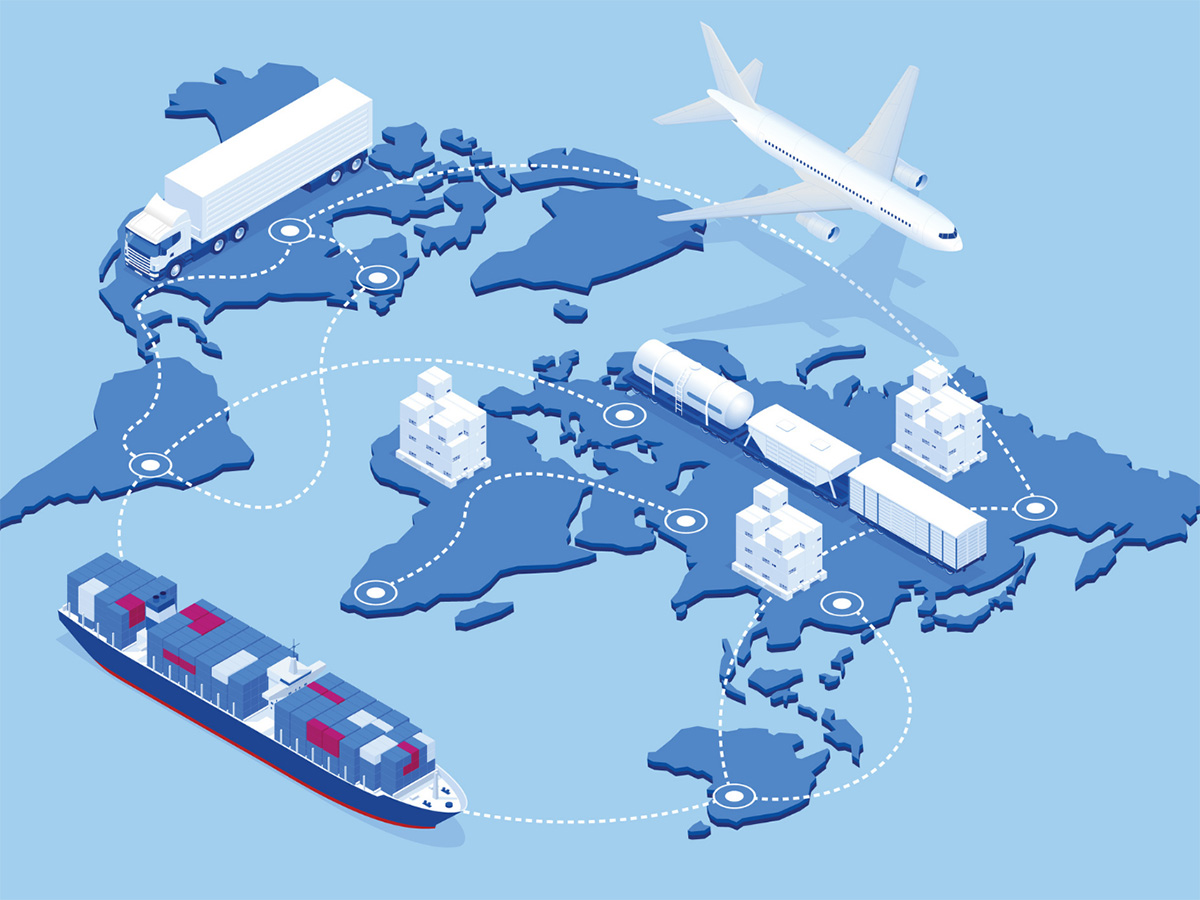

Finance
What Is Supply Chain Forecasting?
Published: October 19, 2023
Discover the importance of supply chain forecasting in finance and how it helps businesses anticipate demand, optimize inventory, and streamline operations.
(Many of the links in this article redirect to a specific reviewed product. Your purchase of these products through affiliate links helps to generate commission for LiveWell, at no extra cost. Learn more)
Table of Contents
- Introduction
- Definition of Supply Chain Forecasting
- Importance of Supply Chain Forecasting
- Challenges in Supply Chain Forecasting
- Methods and Techniques in Supply Chain Forecasting
- Benefits of Supply Chain Forecasting
- Key Factors to Consider in Supply Chain Forecasting
- Best Practices in Supply Chain Forecasting
- Case Studies and Examples of Successful Supply Chain Forecasting
- Conclusion
Introduction
Welcome to the world of supply chain forecasting! In today’s fast-paced and interconnected business landscape, accurate forecasting plays a vital role in optimizing supply chain operations. From retailers to manufacturers to logistics providers, organizations rely on forecasting to effectively plan their inventory, manage demand fluctuations, and ultimately improve overall operational efficiency.
At its core, supply chain forecasting is the process of predicting future demand or supply based on historical data, industry trends, market insights, and other relevant factors. Whether it’s forecasting customer demand for a particular product or estimating the required inventory levels for seamless production, accurate and reliable forecasting is a key driver for success in the world of supply chain management.
The importance of supply chain forecasting cannot be overstated. By accurately predicting future demand or supply, organizations can optimize their inventory levels, minimize stockouts, reduce excess inventory, enhance customer satisfaction, and streamline their overall supply chain processes. In addition, effective forecasting allows businesses to make informed decisions about production and procurement, reduce costs, and maximize profitability.
However, supply chain forecasting is not without its challenges. The dynamic and ever-changing nature of markets, coupled with uncertainties such as weather conditions, economic shifts, and geopolitical factors, pose significant obstacles to accurate forecasting. Inaccurate forecasts can lead to costly inefficiencies, missed opportunities, and customer dissatisfaction.
Fortunately, there are various methods and techniques available to tackle these challenges and improve the accuracy of supply chain forecasting. These include statistical models, advanced analytics, machine learning, data mining, and collaborative forecasting, among others. By leveraging these tools and approaches, organizations can enhance their forecasting capabilities and gain a competitive edge in the market.
In this comprehensive guide, we will delve deeper into the world of supply chain forecasting. We will explore the definition of supply chain forecasting, its importance, the challenges involved, the methods and techniques used, the benefits of effective forecasting, key factors to consider, best practices, and real-world case studies. By the end, you will have a solid understanding of supply chain forecasting and be equipped with valuable insights to optimize your own forecasting processes.
Definition of Supply Chain Forecasting
Supply chain forecasting is the process of estimating future demand or supply for products or services within a supply chain network. It involves analyzing historical data, market trends, customer behavior, and other relevant factors to predict future demand patterns and enable organizations to make informed decisions about production, procurement, and inventory levels.
At its core, supply chain forecasting aims to answer critical questions such as:
- How much of a particular product will customers demand in the future?
- What are the seasonal patterns and trends that affect demand?
- What factors influence customer purchasing decisions?
- How can production and procurement be optimized to meet future demand?
By accurately forecasting demand, organizations can align their production schedules, procurement plans, and inventory levels to meet customer needs while minimizing costs and reducing waste.
Supply chain forecasting can be applied to various stages of the supply chain, including raw material procurement, production planning, distribution, and sales. It involves analyzing historical sales data, market research, customer feedback, industry trends, and other relevant information to identify patterns and make predictions about future demand or supply.
Forecasting methods and techniques can vary depending on the nature of the product, industry dynamics, and the availability of relevant data. Some commonly used techniques include:
- Time series forecasting: This method uses historical sales data to identify patterns and trends and then extrapolates them to predict future demand. It can be applied to both short-term and long-term forecasting.
- Causal forecasting: This approach considers the relationships between demand and various factors like pricing, marketing campaigns, economic conditions, and environmental factors to predict future demand.
- Judgmental forecasting: In this technique, experts or experienced individuals use their intuition and industry knowledge to estimate future demand. This method is useful in situations where historical data might be limited or unreliable.
- Collaborative forecasting: This involves gathering input from multiple stakeholders, including suppliers, customers, and internal teams, to gain insights into future demand and align supply chain activities accordingly.
Supply chain forecasting is an ongoing process that requires continuous monitoring and refinement. As market dynamics evolve and new trends emerge, organizations must adapt their forecasting models to ensure accuracy and effectiveness.
In the next sections, we will explore the importance of supply chain forecasting, the challenges it presents, and the methods and techniques used to overcome these challenges and improve forecasting accuracy.
Importance of Supply Chain Forecasting
Supply chain forecasting plays a pivotal role in optimizing supply chain operations and driving overall organizational success. Here are key reasons why supply chain forecasting is of paramount importance:
- Inventory optimization: Accurate forecasting enables organizations to optimize their inventory levels by aligning supply with expected demand. By forecasting future demand patterns, businesses can ensure they have the right amount of inventory on hand to meet customer needs without incurring excess carrying costs or stockouts.
- Production planning: Forecasts provide valuable insights to help organizations plan their production schedules, allocate resources, and optimize capacity utilization. By knowing the expected demand, businesses can adjust manufacturing processes, streamline workflows, and minimize idle time, which ultimately results in cost savings and improved operational efficiency.
- Improved customer service: By accurately predicting future demand, organizations can ensure they have the right products available at the right time. This translates into improved customer satisfaction, as customers can find the products they need without facing stockouts or long lead times. Consistently meeting customer demands leads to enhanced brand reputation and loyalty.
- Effective procurement: Supply chain forecasting helps organizations optimize their procurement processes by providing insights into expected future demand. By knowing the anticipated demand for raw materials or components, businesses can negotiate better contracts, secure supply agreements, and avoid excessive inventory holding costs.
- Cost reduction: Accurate forecasting allows organizations to reduce costs by minimizing excess inventory and avoiding stockouts. By aligning supply with demand, businesses can optimize their storage and warehousing costs, reduce the risk of obsolete inventory, and avoid rush orders or emergency shipments which are often more expensive.
- Flexibility and responsiveness: Effective forecasting enables organizations to be agile and responsive to changes in market demands. By having a clear understanding of expected demand patterns, businesses can quickly adjust their production schedules, inventory levels, and supply chain processes to respond to fluctuations or unexpected events.
- Strategic decision-making: Accurate forecasting provides valuable insights for strategic decision-making. It helps organizations evaluate the viability of new product launches, plan market expansions, optimize pricing strategies, and identify opportunities for growth in specific regions or customer segments.
- Collaboration and coordination: Supply chain forecasting encourages collaboration and coordination among stakeholders within the supply chain network. By involving suppliers, customers, and internal teams in the forecasting process, organizations can ensure that all parties have a shared understanding of future demand, fostering stronger relationships and enabling more effective supply chain management.
In summary, supply chain forecasting is a critical component of successful supply chain management. It provides organizations with the insights needed to optimize inventory, production, procurement, and customer service. By accurately predicting future demand, organizations can reduce costs, improve operational efficiency, enhance customer satisfaction, and gain a competitive edge in the market.
Challenges in Supply Chain Forecasting
While supply chain forecasting is crucial for effective planning and optimization, it does come with a set of challenges. These challenges can impact the accuracy and reliability of forecasts, leading to inefficiencies within the supply chain. Here are key challenges in supply chain forecasting:
- Uncertainties in demand patterns: Demand patterns can be influenced by various external factors, such as changes in consumer preferences, economic conditions, weather patterns, and competitor actions. These uncertainties can make it challenging to accurately predict future demand, especially for new and innovative products or in volatile markets.
- Data quality and availability: The accuracy and relevance of historical data are critical for forecasting. However, organizations may face challenges in obtaining high-quality and up-to-date data. Incomplete or inconsistent data can lead to inaccurate forecasts and unreliable planning decisions.
- Short product life cycles: In industries where products have short life cycles, accurate forecasting becomes even more critical. Rapid changes in customer preferences, market trends, and technological advancements make it challenging to predict demand accurately and plan production and inventory accordingly.
- Supply chain complexity: Modern supply chains can be complex, involving multiple tiers of suppliers, global distribution networks, and intricate relationships among various stakeholders. Managing the flow of information and materials across the supply chain can create challenges in obtaining accurate and real-time data, which in turn impacts the accuracy of demand forecasts.
- Lack of collaboration: Inadequate collaboration among stakeholders can hinder forecasting accuracy. When different parties do not share their insights and knowledge, it becomes challenging to incorporate diverse perspectives and factors that influence demand. Lack of collaboration can also lead to delays in capturing demand information and result in inaccurate forecasts.
- Volatility and seasonality: Markets affected by seasonality and volatility present unique forecasting challenges. Fluctuations in customer demand during peak seasons or sudden shifts due to external events require sophisticated forecasting techniques to account for these variations and make accurate predictions.
- Product and SKU proliferation: Organizations offering a wide range of products or SKUs face challenges in accurately forecasting demand for each individual item. The increased complexity and variation in customer preferences require robust systems and processes to manage the forecasting and inventory optimization for a diverse product portfolio.
- Internal alignment and coordination: Coordination and communication across different departments, such as sales, marketing, operations, and finance, are essential for accurate forecasting. Lack of alignment can lead to discrepancies in demand forecasts, resulting in inefficient inventory management and planning.
These challenges highlight the importance of employing advanced forecasting techniques, leveraging technology, improving data management processes, and fostering collaboration among stakeholders. Overcoming these challenges enables organizations to enhance the accuracy and efficiency of their supply chain forecasting, leading to improved planning, reduced costs, and better customer service.
Methods and Techniques in Supply Chain Forecasting
Supply chain forecasting encompasses a variety of methods and techniques that organizations can utilize to predict future demand patterns and optimize their supply chain operations. Choosing the appropriate forecasting method depends on factors such as data availability, the nature of the product or service, historical demand patterns, and industry dynamics. Here are some commonly used methods and techniques in supply chain forecasting:
- Time series forecasting: This method relies on analyzing historical demand data to identify patterns and trends, which are then used to forecast future demand. Time series forecasting techniques can include moving averages, exponential smoothing, and trend analysis. These methods are particularly effective in situations where demand patterns are consistent and do not significantly change over time.
- Causal forecasting: Causal forecasting examines the cause-and-effect relationships between demand and various external factors. This technique involves analyzing historical data on sales, promotions, pricing, economic indicators, and other factors that can impact demand. Causal forecasting methods include regression analysis, econometric models, and simulations. Causal forecasting is especially useful when there are clear causal links between demand and external variables.
- Judgmental forecasting: In situations where historical data is limited or unreliable, judgmental forecasting techniques come into play. This approach relies on the expertise and experience of individuals or panels of experts who provide their subjective opinions on future demand. Delphi method, scenario analysis, and market research are examples of judgmental forecasting techniques. Judgmental forecasts are valuable when there are significant market changes, new product launches, or limited historical data available.
- Collaborative forecasting: Collaborative forecasting requires active involvement and input from various stakeholders, such as suppliers, customers, and internal teams. This technique leverages the collective knowledge and insights of different parties to improve the accuracy of forecasts. Collaborative forecasting fosters better communication, information sharing, and transparency among supply chain partners, resulting in more accurate and reliable demand forecasts.
- Machine learning and predictive analytics: Advanced technologies such as machine learning algorithms and predictive analytics are increasingly being adopted for supply chain forecasting. These techniques can analyze large volumes of data, identify hidden patterns, and make predictions based on complex relationships. Machine learning models can automatically adjust and improve their performance based on new data inputs, enhancing forecast accuracy over time.
- Hybrid forecasting: Hybrid forecasting methods combine multiple techniques mentioned above to leverage the strengths of each approach. For example, a hybrid approach may involve combining time series forecasting with causal analysis to capture both historical patterns and external factors that impact demand. Hybrid forecasting allows organizations to overcome limitations of individual methods and improve overall forecast accuracy.
It is essential for organizations to select the appropriate forecasting method based on their specific needs and the characteristics of their supply chain. Moreover, leveraging technology, implementing robust data management practices, and constantly refining forecasting models are crucial to enhancing the accuracy and effectiveness of supply chain forecasting.
In the next sections, we will explore the benefits of supply chain forecasting, key factors to consider when forecasting, best practices, and real-world case studies that demonstrate successful implementation of supply chain forecasting techniques.
Benefits of Supply Chain Forecasting
Supply chain forecasting offers numerous benefits for organizations looking to optimize their operations, enhance customer satisfaction, and improve their bottom line. Here are the key benefits of effective supply chain forecasting:
- Optimized inventory levels: Accurate forecasting helps organizations optimize their inventory levels by aligning supply with expected demand. This reduces carrying costs associated with excessive inventory and minimizes stockouts, ensuring that the right products are available at the right time.
- Improved customer service: Forecasting enables organizations to meet customer demand more effectively. By having the right products in stock, businesses can avoid stockouts and reduce lead times, enhancing customer satisfaction and loyalty.
- Enhanced operational efficiency: Supply chain forecasting allows organizations to plan production and procurement activities more efficiently. By aligning production with expected demand, businesses can prevent underutilization or overutilization of resources, streamline workflows, and optimize capacity utilization.
- Reduced costs: Accurate forecasting helps organizations reduce costs in various ways. By avoiding excessive inventory, businesses can minimize storage costs and reduce the risk of inventory obsolescence. Additionally, better planning and demand anticipation can help optimize procurement activities, negotiate better contracts with suppliers, and avoid rush orders or emergency shipments that often come with additional costs.
- Strategic decision-making: Supply chain forecasting provides valuable insights for strategic decision-making. By understanding future demand trends, organizations can evaluate the viability of new product launches, plan market expansions, optimize pricing strategies, and identify opportunities for growth.
- Improved collaboration: Forecasting encourages collaboration among stakeholders within the supply chain network. By involving suppliers, customers, and internal teams in the forecasting process, organizations can foster stronger relationships, share relevant information, and coordinate their activities more effectively.
- Flexibility and responsiveness: Accurate forecasting enables organizations to be more agile and responsive to changes in market conditions. With a clear understanding of expected demand patterns, businesses can quickly adjust their production schedules, inventory levels, and supply chain processes to respond to fluctuations or unexpected events.
- Supply chain risk management: Forecasting helps organizations identify potential risks and develop contingency plans to mitigate them. By anticipating changes in demand, businesses can proactively manage supply chain disruptions, such as supplier delays or transportation issues.
- Competitive advantage: Organizations that leverage effective supply chain forecasting gain a competitive advantage in the market. By consistently meeting customer demands, minimizing costs, and optimizing supply chain operations, businesses can differentiate themselves and outperform competitors.
Overall, effective supply chain forecasting enables organizations to make informed decisions, improve operational efficiency, reduce costs, enhance customer satisfaction, and gain a competitive edge. By deploying the right forecasting methods and continuously refining their processes, businesses can unlock the full potential of their supply chain and drive long-term success.
Key Factors to Consider in Supply Chain Forecasting
Supply chain forecasting relies on various factors that must be carefully considered to ensure accurate and reliable predictions. By taking into account these key factors, organizations can improve the effectiveness of their forecasting processes and enhance overall supply chain management. Here are the main factors to consider in supply chain forecasting:
- Historical data: The quality and availability of historical data significantly impact the accuracy of forecasts. Organizations must ensure that they have access to reliable and relevant historical data to build forecasting models. This includes sales data, production records, customer insights, and other relevant data sources. Data cleansing and preprocessing techniques may be necessary to remove outliers and inconsistencies that could distort forecasts.
- Market dynamics and trends: An understanding of market dynamics, including industry trends, competitor behavior, and changes in consumer preferences, is crucial for accurate forecasting. Organizations must monitor market conditions and stay up to date with industry developments that can influence demand patterns, such as economic fluctuations, technological advancements, and regulatory changes.
- Lead times: The lead time required to fulfill customer orders is an essential factor in supply chain forecasting. Organizations must account for lead times in their forecasting models to ensure that the estimated demand aligns with the required production and delivery schedules.
- Seasonality and trends: Many products experience seasonal fluctuations in demand. Understanding seasonal patterns and trends is critical to accurately forecasting demand and planning inventory levels and production schedules accordingly. Additionally, organizations should consider long-term trends that may impact demand, such as changing consumer preferences or emerging market segments.
- Promotions and marketing campaigns: Promotions and marketing activities can have a significant impact on demand. Organizations must consider the timing and impact of marketing campaigns, discounts, promotions, and other sales activities in their forecasting models to accurately predict demand during these periods.
- External factors: External factors, such as weather conditions, natural disasters, economic conditions, and geopolitical events, can influence demand patterns. Organizations should assess and integrate these external factors into their forecasting models to account for potential disruptions and fluctuations in demand.
- Collaboration and communication: Effective collaboration and communication among supply chain stakeholders is crucial for accurate forecasting. This includes involving suppliers, customers, and internal teams in the forecasting process to gather insights, share information, and align expectations. Regular communication and feedback loops help refine forecasts and improve overall supply chain coordination.
- Technology and tools: Leveraging advanced technologies and forecasting tools can enhance the accuracy and efficiency of supply chain forecasting. Machine learning algorithms, predictive analytics, demand planning software, and data visualization tools empower organizations to analyze large datasets, identify patterns, and make more accurate predictions.
- Continuous improvement: Supply chain forecasting is an iterative process that requires ongoing monitoring, evaluation, and improvement. Organizations should regularly review the accuracy of their forecasts, analyze forecast errors, and identify areas for enhancement. By learning from past performance, organizations can refine their forecasting models and strategies to continuously improve forecast accuracy.
By carefully considering these key factors in supply chain forecasting, organizations can enhance the accuracy and effectiveness of their predictions, leading to better planning, improved customer service, and optimized supply chain operations.
Best Practices in Supply Chain Forecasting
To optimize the accuracy and effectiveness of supply chain forecasting, organizations can implement several best practices. By following these practices, businesses can improve their forecasting processes and enhance overall supply chain management. Here are some key best practices in supply chain forecasting:
- Data quality and management: Ensure that historical data used for forecasting is accurate, complete, and relevant. Implement robust data management practices to cleanse, validate, and organize the data. Regularly update and maintain the database to keep it current and reliable.
- Collaboration and information sharing: Foster collaboration among internal teams, suppliers, and customers. Engage in regular meetings and discussions to gather valuable insights, share information, and align expectations. Collaborative forecasting ensures that a diverse range of perspectives and knowledge are considered, leading to more accurate and reliable forecasts.
- Establish clear communication channels: Develop a streamlined communication process to share forecasts and related information with stakeholders within the supply chain network. Clear and timely communication helps ensure that all parties have access to accurate forecasts, enabling better coordination of activities and alignment of resources.
- Use advanced forecasting techniques: Explore and leverage advanced forecasting techniques such as statistical models, machine learning algorithms, and predictive analytics. These techniques can capture complex patterns, detect subtle trends, and improve accuracy compared to traditional forecasting methods.
- Monitor and measure forecast accuracy: Regularly evaluate the accuracy of forecasts by comparing them to actual demand data. Analyze forecast errors to identify patterns, trends, and areas for improvement. Use key performance indicators (KPIs) such as mean absolute percentage error (MAPE) to quantify forecast accuracy and track improvements over time.
- Continuously update forecasts: Forecasts should not be treated as static; update them regularly based on new data and changes in market conditions. Incorporate the latest information on market trends, customer behavior, and other factors that impact demand. Timely updates ensure that forecasts remain relevant, accurate, and actionable.
- Consider multiple forecast scenarios: Develop and evaluate multiple forecast scenarios to account for different possibilities. Assess best-case, worst-case, and most-likely scenarios to better understand the potential outcomes and associated risks. Scenario planning helps organizations prepare contingencies and make informed decisions for different demand scenarios.
- Invest in technology: Leverage technology solutions, such as demand planning software and advanced analytics tools, to automate and streamline forecasting processes. These tools can handle large datasets, analyze patterns quickly, generate accurate forecasts, and provide valuable insights for decision-making.
- Regularly review and improve forecasting models: Continuously evaluate the performance of forecasting models and identify areas for improvement. Take into account feedback from stakeholders and incorporate lessons learned from past forecasts. Adjust and refine forecasting models and methodologies to enhance forecast accuracy and effectiveness.
- Monitor external factors: Track and monitor external factors that can impact demand, such as changes in regulations, industry trends, economic conditions, and customer preferences. Stay informed about market dynamics and incorporate this information into the forecasting process to improve the accuracy of predictions.
By implementing these best practices, organizations can enhance the accuracy and reliability of their supply chain forecasting, leading to improved planning, optimized inventory levels, better customer service, and increased operational efficiency.
Case Studies and Examples of Successful Supply Chain Forecasting
Examining real-world examples of successful supply chain forecasting can provide valuable insights and inspiration for organizations looking to improve their own forecasting processes. Here are two case studies illustrating the impact of effective supply chain forecasting:
- Wal-Mart: Wal-Mart, the multinational retail corporation, has been widely recognized for its accurate supply chain forecasting practices. By leveraging advanced data analytics and demand forecasting algorithms, Wal-Mart is able to forecast demand with remarkable accuracy. For instance, during hurricane seasons, Wal-Mart utilizes data on weather patterns, historical sales, and customer behavior to forecast demand for emergency supplies, such as water and batteries. These accurate forecasts enable Wal-Mart to stock sufficient inventory in affected areas ahead of time, ensuring that customers have access to essential products when they need them most. Wal-Mart’s robust forecasting capabilities have contributed to its consistent supply chain performance and customer satisfaction.
- Amazon: The success of Amazon, the e-commerce giant, can be attributed in part to its sophisticated supply chain forecasting capabilities. Amazon has developed a highly advanced demand forecasting system that incorporates machine learning algorithms and real-time data analytics. By analyzing vast amounts of customer data, order history, clickstream behavior, and external trends, Amazon can accurately predict demand patterns and optimize its inventory planning and distribution network. This allows Amazon to offer a vast selection of products, maintain high fulfillment rates, and minimize stockouts. Additionally, through its innovative Prime program, Amazon leverages demand forecasting to provide faster shipping and meet customers’ expectations for quick delivery.
These case studies demonstrate how accurate supply chain forecasting can significantly impact the success of organizations. By leveraging advanced technologies, data analytics, and forecasting algorithms, companies like Wal-Mart and Amazon can align their operations, optimize inventory levels, and meet customer demands with precision.
It is important to note that successful supply chain forecasting is not limited to large organizations. Small and medium-sized businesses (SMBs) can also benefit from effective forecasting practices. SMBs can leverage demand planning software, collaborate closely with suppliers and customers, monitor market trends, and continuously refine their forecasting models to achieve desired outcomes.
By studying these successful examples and applying their principles to their own supply chain operations, organizations can enhance their forecasting capabilities, improve supply chain performance, and gain a competitive advantage in the market.
Conclusion
Supply chain forecasting is a critical aspect of successful supply chain management. By accurately predicting future demand or supply, organizations can optimize their inventory levels, streamline production planning, enhance customer service, and reduce costs. Effective forecasting allows businesses to make informed decisions, improve operational efficiency, and gain a competitive edge in the market.
In this comprehensive guide, we explored the definition of supply chain forecasting, its importance, and the challenges associated with it. We discussed various methods and techniques used in supply chain forecasting, such as time series forecasting, causal analysis, and collaborative forecasting. We also highlighted the benefits of accurate forecasting, including optimized inventory levels, improved customer service, and strategic decision-making.
Furthermore, we examined key factors that organizations should consider in supply chain forecasting, such as historical data quality, market dynamics, and collaboration among stakeholders. Best practices such as data management, collaboration, using advanced techniques, and continuous improvement were also emphasized to enhance forecasting accuracy and reliability.
Real-world case studies of companies like Wal-Mart and Amazon demonstrated the impact of effective supply chain forecasting on operational performance and customer satisfaction. These examples showcased how accurate forecasting, enabled by advanced technologies and data analytics, can optimize inventory planning, ensure timely replenishment, and meet customer demands with precision.
In conclusion, supply chain forecasting is a dynamic and essential process that requires careful consideration of various factors. By implementing best practices, leveraging advanced techniques, and continuously improving forecasting models, organizations can optimize their supply chain operations, reduce costs, enhance customer satisfaction, and achieve long-term success in today’s competitive business landscape.














